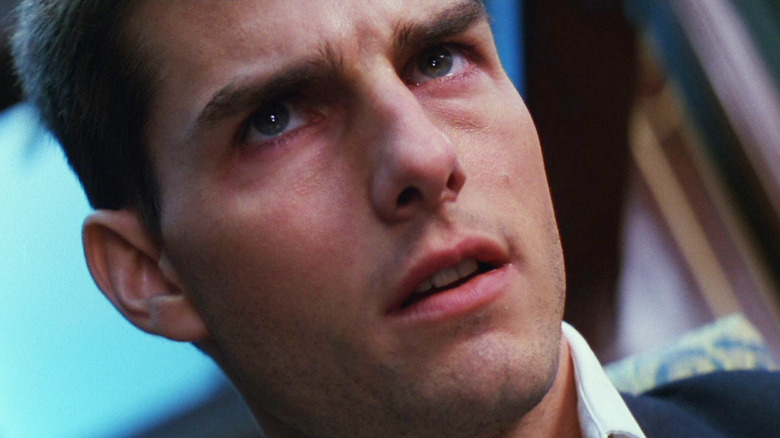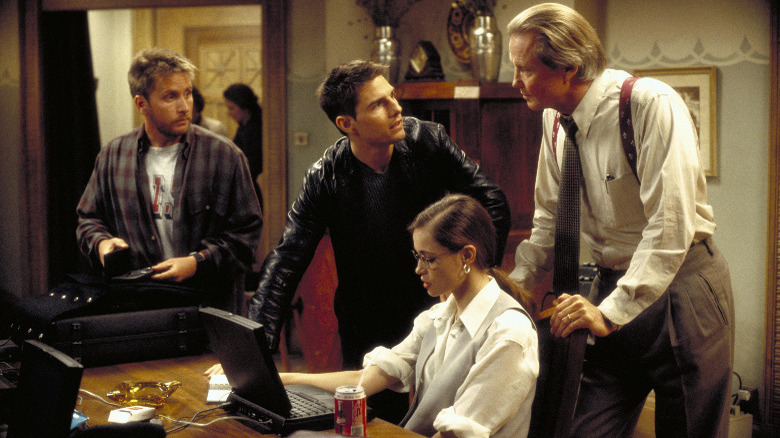George Lucas Gave A Crucial Piece Of Advice That Helped Shape The First Mission: Impossible Movie
Brian De Palma's 1996 film "Mission: Impossible" is quite different from the Tom Cruise thrillers audiences have gotten used to watching since. Where the franchise's sequels would see Cruise putting his very life on the line, the first movie's stunts and set pieces are relatively down to earth. "Relatively," mind you, is the key term here. De Palma's film climaxes with a scene where characters hop back and forth between a high-speed train and a helicopter, so plausibility isn't what you would call a pressing concern, per se.
Another big difference is Cruise's Ethan Hunt. When we meet him in De Palma's film, Ethan is still fairly wet behind the ears and delights in sassing his Impossible Mission Force team's leader and no-nonsense mentor, Jim Phelps (Jon Voight). The latter character, for those not aware, was one of the leads on the original 1960s "Mission: Impossible" TV series, which technically makes De Palma's movie a legacy sequel to the show. This is also why Peter Graves, who played Mr. Phelps on the series, was rather unhappy to learn his old character (spoiler?) was secretly the bad guy in the film.
Funny enough, though, Jim being the villain isn't the biggest twist in De Palma's film. That honor goes to the first 25 minutes, in which most of Ethan's team is killed in action — save for Jim, who fakes his death, and his wife, Claire (Emmanuelle Béart), who conspires with her husband to pin the blame for the mission gone sideways on Ethan. Appearing on the "Script Apart" podcast years later, co-writer David Koepp revealed it was actually George Lucas who came up with the missing element that makes the shocking turn of events so effective.
'You're missing the spaghetti scene'
After its Kiev-set prologue and opening credits, "Mission: Impossible" finds Jim, Ethan, and the rest of the crew gathered in Prague to discuss their latest operation. What follows is a scene in which the personalities of the team's members are quickly laid out, along with their skill-sets and one-on-one dynamics. Emilio Estevez's tech-whiz Jack, for example, flirts with Kristin Scott Thomas' ever-composed field agent Sarah and wryly cautions Ethan against chewing his explosive "gum" (Chekhov's gum?). Meanwhile, Ethan pokes fun at Jim's "cushy recruiting assignments" and mocks Claire's less-than-stellar coffee.
It was Brian De Palma's old pal George Lucas who recognized the necessity of this scene. As David Koepp recalled:
"Brian [De Palma] had shown an early cut of the movie to some filmmaker friends. And George Lucas saw it and said, 'You're missing the spaghetti scene.' ... Brian said, 'What's the spaghetti scene?' And he said, 'You know, where they all sit around and eat spaghetti and they get the mission. You don't know who these people are. You start in the middle of a mission.' Brian said, 'Well, it's exciting to start in the middle of a mission.' And George said, 'It's not exciting unless you know who they are.'"
Calling this an "excellent point," Koepp went back and penned the scene in question. The final result comes across as standard table-setting in the moment, making it all the more surprising when most of the heroes are dead 15 minutes later. It helped that much of Jim and Ethan's crew were played by actors who were well known circa 1996, further misleading audiences at the time into assuming this would be the ensemble for the majority of the film.
Just goes to show, screenwriters of the world: Never forget your spaghetti scene.

